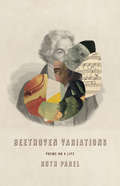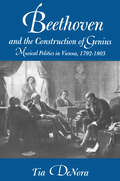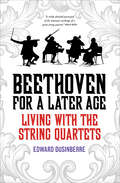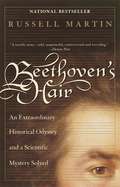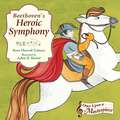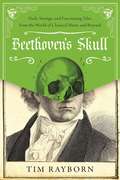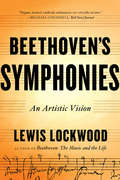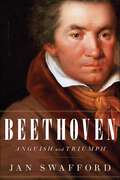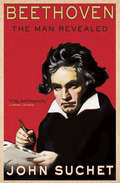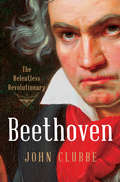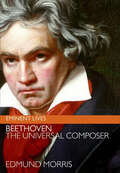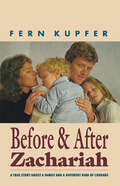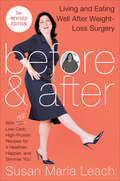- Table View
- List View
Beethoven Variations: Poems on a Life
by Ruth PadelA fascinating poetic journey into the mind and heart of a musical genius, from the author of the celebrated Darwin: A Life in PoemsRuth Padel's new sequence of poems, in four movements, is a personal voyage through the life and legend of one of the world's greatest composers. She uncovers the man behind the music, charting his private thoughts and feelings through letters, diaries, sketchbooks, and the conversation books he used as his hearing declined. She gives us Beethoven as a battered four-year-old, weeping at the clavier; the young virtuoso pianist agonized by his encroaching deafness; the passionate, heartbroken lover; the clumsy eccentric making coffee with exactly sixty beans. Padel's quest takes her into the heart of Europe and back to her own musical childhood: Her great-grandfather, who studied in Leipzig with a pupil of Beethoven's, became a concert pianist before migrating to Britain; her parents met making music; and Padel grew up playing the viola, Beethoven's instrument as a child. Her book is a poet and string player's intimate connection across the centuries with an artist who, though increasingly isolated, ended even his most harrowing works on a note of hope.
Beethoven and the Construction of Genius: Musical Politics in Vienna, 1792-1803
by Tia DeNoraIn this provocative account Tia DeNora reconceptualizes the notion of genius by placing the life and career of Ludwig van Beethoven in its social context. She explores the changing musical world of late eighteenth-century Vienna and follows the activities of the small circle of aristocratic patrons who paved the way for the composer's success.DeNora reconstructs the development of Beethoven's reputation as she recreates Vienna's robust musical scene through contemporary accounts, letters, magazines, and myths—a colorful picture of changing times. She explores the ways Beethoven was seen by his contemporaries and the image crafted by his supporters. Comparing Beethoven to contemporary rivals now largely forgotten, DeNora reveals a figure musically innovative and complex, as well as a keen self-promoter who adroitly managed his own celebrity.DeNora contends that the recognition Beethoven received was as much a social achievement as it was the result of his personal gifts. In contemplating the political and social implications of culture, DeNora casts many aspects of Beethoven's biography in a new and different light, enriching our understanding of his success as a performer and composer.
Beethoven for Kids: His Life and Music with 21 Activities
by Helen BauerLudwig van Beethoven, one of the most influential composers of all time, is brought vividly to life and made relevant to today's young musicians in Beethoven for Kids. Children will learn about Beethoven's troubled childhood and family life, early gift and passion for music, volatile personality, championing of equality and freedom, and persistence in his work despite increasing hearing loss. The great musicians, thinkers, and movements of Beethoven's time, from Mozart and Haydn to the bold new ideas of the Enlightenment, are presented and their profound effect on the composer's life and music explained. Twenty-one engaging activities, including singing musical variations, dancing a Viennese waltz, creating an operatic diorama, and making a model eardrum, illuminate Beethoven's life, times, and work. A time line, a glossary, online resources, and recordings and reading lists for further listening and study round out this comprehensive resource.
Beethoven for a Later Age: Living with the String Quartets
by Edward Dusinberre&“A richly detailed portrayal of the intimate workings of a great string quartet . . . as revealed to us through the recollections of its first violinist.&”—Philip Roth Edward Dusinberre, first violinist of the renowned Takács Quartet, offers a rare peek inside the workings of his ensemble, while providing an insightful history of Beethoven&’s sixteen string quartets and their performance. Founded in Hungary in 1975 and now based in Boulder, Colorado, the Takács is one of the world&’s preeminent string quartets, and performances of Beethoven have been at the center of their work together for over forty years. Using the history of both the Takács Quartet and the Beethoven quartets as a foundation, Beethoven for a Later Age provides a backstage look at the daily life of a quartet, showing the necessary creative tension between individual and group and how four people can at the same time forge a lasting artistic connection and enjoy making music together over decades. In an accessible style, suitable for novices and chamber music enthusiasts alike, Dusinberre illuminates the variety and contradictions of Beethoven&’s quartets, which were composed against the turbulent backdrop of the Napoleonic Wars and their aftermath, and he brings the technical aspects of the music to life. &“We are given intimate insight into the almost impossible-to-describe musical process of rehearsal and performance, the artistic and human interaction that links these modern musicians with their forebears and Beethoven himself.&”—Garrick Ohlsson, pianist &“This singular memoir . . . will be something between informative and revelatory to readers from musicians to music lovers.&”—Jan Swafford, author of Beethoven: Anguish and Triumph
Beethoven in the Bunker: Musicians Under the Nazi Regime
by Fred BrouwersThis compelling survey examines the remarkable relationship between the Nazis and classical music through the stories of musicians, composers, and conductors across the political spectrum.May 1945. A Soviet military patrol searches Hitler&’s secret bunker in Berlin. They find bodies, documents, jewelry, paintings—and also an extensive collection of 78 rpm records. It comes as no surprise that this collection includes work by Beethoven, Wagner, and Bruckner. The same goes for a procession of other giants promoted by the Nazi regime: &“It seems as if the Nazis put a steel helmet on Mozart, girded Schubert with a saber, and wrapped barbed wire around Johann Strauss&’s neck,&” composer Robert Stolz once said. But how is it possible that Hitler&’s favorites also included &“forbidden&” Jewish and Russian composers and performers? While Hitler sat secretly enjoying previously recorded music in his bunker, musicians made of flesh and blood were denied a means of making a living. They died in concentration camps or in other war-related circumstances. They survived but ended up in psychiatric care; they managed to flee just in time; they sided with the regime—out of conviction or coercion—or they joined the resistance. From fiery conductor Arturo Toscanini, who defied Mussolini and Hitler, to opportunistic composer Richard Strauss and antisemitic pianist Elly Ney, who collaborated with the Third Reich to varying extents and for different reasons, Fred Brouwers profiles the complex figures of this extraordinarily fascinating chapter in music history.
Beethoven's Eroica: The First Great Romantic Symphony
by James Hamilton-PatersonAn ode to Beethoven's revolutionary masterpiece, his Third Symphony In 1805, the world of music was startled by an avant-garde and explosive new work. Intellectually and emotionally, Beethoven's Third Symphony, the "Eroica," rudely broke the mold of the Viennese Classical symphony and revealed a powerful new expressiveness, both personal and societal. Even the whiff of actual political revolution was woven into the work-it was originally inscribed to Napoleon Bonaparte, a dangerous hero for a composer dependent on conservative royal patronage. With the first two stunning chords of the "Eroica," classical music was transformed.In Beethoven's Eroica, James Hamilton-Paterson reconstructs this great moment in Western culture, the shock of the music and the symphony's long afterlife.
Beethoven's Hair: An Extraordinary Historical Odyssey and a Scientific Mystery Solved
by Russell MartinReaders will follow the strange, yet true, journey made by a lock of Ludwig van Beethovens hair from the time it was clipped from the composers head on his deathbed in Germany in 1827 to a World War II refugee safe house in Denmark in 1943 to its eventual sale at auction in 1994. From this lock of hair, scientists were able to discover the cause of Beethovens death, a question that had long puzzled scientists and musicologists.
Beethoven's Heroic Symphony (Once Upon a Masterpiece #4)
by Anna Harwell CelenzaDiscover the little-known story of Beethoven's beloved masterwork. As the best pianist in Vienna, Ludwig van Beethoven had everything: talent, money, fame. But he also had a terrible secret. He was slowly going deaf. Though his hearing deserted him, the maestro never lost his music. Seeking inspiration for his compositions, Beethoven hit upon Napoleon Bonaparte, then considered a liberator and a folk hero. Soon after Beethoven completed the work, Napoleon declared himself Emperor of France; betrayed and enraged, Beethoven tore his copy of the score to pieces. But his friend Ferdinand rescued a copy, and in time, Beethoven renamed it Eroica: the Heroic Symphony, dedicated to hero in each and every one of us.
Beethoven's Skull: Dark, Strange, and Fascinating Tales from the World of Classical Music and Beyond
by Tim RaybornBeethoven's Skull is an unusual and often humorous survey of the many strange happenings in the history of Western classical music. Proving that good music and shocking tabloid-style stories make excellent bedfellows, it presents tales of revenge, murder, curious accidents, and strange fates that span more than two thousand years. Highlights include: A cursed song that kills those who hear it A composer who lovingly cradles the head of Beethoven's corpse when his remains are exhumed half a century after his death A fifteenth-century German poet who sings of the real-life Dracula A dream of the devil that inspires a virtuoso violin pieceUnlike many music books that begin their histories with the seventeenth or eighteenth centuries, Beethoven's Skull takes the reader back to the world of ancient Greece and Rome, progressing through the Middle Ages and all the way into the twentieth century. It also looks at myths and legends, superstitions, and musical mysteries, detailing the ways that musicians and their peers have been rather horrible to one another over the centuries.
Beethoven's Symphonies: An Artistic Vision
by Lewis LockwoodAn exploration of the unswerving artistic vision underlying Beethoven’s symphonies, from one of the world’s leading scholars of the composer’s works. More than any other composer, Beethoven left to posterity a vast body of material that documents the early stages of almost everything he wrote. From this trove of sketchbooks, Lewis Lockwood draws us into the composer’s mind, unveiling a creative process of astonishing scope and originality. For musicians and nonmusicians alike, Beethoven’s symphonies stand at the summit of artistic achievement, loved today as they were two hundred years ago for their emotional cogency, variety, and unprecedented individuality. Beethoven labored to complete nine of them over his lifetime—a quarter of Mozart’s output and a tenth of Haydn’s—yet no musical works are more iconic, more indelibly stamped on the memory of anyone who has heard them. They are the products of an imagination that drove the composer to build out of the highest musical traditions of the past something startlingly new. Lockwood brings to bear a long career of studying the surviving sources that yield insight into Beethoven’s creative work, including concept sketches for symphonies that were never finished. From these, Lockwood offers fascinating revelations into the historical and biographical circumstances in which the symphonies were composed. In this compelling story of Beethoven’s singular ambition, Lockwood introduces readers to the symphonies as individual artworks, broadly tracing their genesis against the backdrop of political upheavals, concert life, and their relationship to his major works in other genres. From the first symphonies, written during his emerging deafness, to the monumental Ninth, Lockwood brings to life Beethoven’s lifelong passion to compose works of unsurpassed beauty.
Beethoven, A Life
by Jan CaeyersThis internationally bestselling biography of Ludwig van Beethoven, now translated into English for the first time, offers connoisseurs and newcomers alike an unparalleled story of the composer’s life and works. With unprecedented access to the archives at the Beethoven House in Bonn, renowned Beethoven conductor and scholar Jan Caeyers expertly weaves together a deeply human and complex image of Beethoven—his troubled youth, his unpredictable mood swings, his desires, relationships, and conflicts with family and friends, the mysteries surrounding his affair with the "immortal beloved," and the dramatic tale of his deafness. Caeyers also offers new insights into Beethoven’s music and its gradual transformation from the work of a skilled craftsman into that of a consummate artist. Demonstrating an impressive command of the vast scholarship on this iconic composer, Caeyers brings Beethoven’s world alive with elegant prose, memorable musical descriptions, and vivid depictions of Bonn and Vienna—the cities where Beethoven produced and performed his works. Caeyers explores how Beethoven’s career was impacted by the historical and philosophical shifts taking place in the music world, and conversely, how his own trajectory changed the course of the music industry. Equal parts absorbing cultural history and lively biography, Beethoven, A Life paints a complex portrait of the musical genius who redefined the musical style of his day and went on to become one of the great pillars of Western art music.
Beethoven: A Life in Nine Pieces
by Laura TunbridgeA major new biography published for the 250th anniversary of Beethoven&’s birth, offering a fresh, human portrayal &“Illuminating. . . . Tunbridge&’s pithy A Life in Nine Pieces is different and welcome: a biography presented through the focus of nine different compositions.&”—Fiona Maddocks, The Guardian&“Rewarding. . . . A lot of information is packed into her musical portraits.&”—Richard Fairman, Financial Times The iconic image of Beethoven is of him as a lone genius: hair wild, fists clenched, and brow furrowed. Beethoven may well have shaped the music of the future, but he was also a product of his time, influenced by the people, politics, and culture around him. Oxford scholar Laura Tunbridge offers an alternative history of Beethoven&’s career, placing his music in contexts that shed light on why particular pieces are valued more than others, and what this tells us about his larger-than-life reputation. Each chapter focuses on a period of his life, a piece of music, and a revealing theme, from family to friends, from heroism to liberty. We discover, along the way, Beethoven&’s unusual marketing strategies, his ambitious concert programming, and how specific performers and instruments influenced his works. This book offers new ways to understand Beethoven and why his music continues to be valued today.
Beethoven: A Political Artist in Revolutionary Times (Eastman Studies In Music Ser. #172)
by William KindermanWe have long regarded Beethoven as a great composer, but we rarely appreciate that he was also an eminently political artist. This book unveils the role of politics in his oeuvre, elucidating how the inherently political nature of Beethoven’s music explains its power and endurance. William Kinderman presents Beethoven as a civically engaged thinker faced with severe challenges. The composer lived through many tumultuous events—the French Revolution, the rise and fall of Napoleon Bonaparte, and the Congress of Vienna among them. Previous studies of Beethoven have emphasized the importance of his personal suffering and inner struggles; Kinderman instead establishes that musical tensions in works such as the Eroica, the Appassionata, and his final piano sonata in C minor reflect Beethoven’s attitudes toward the political turbulence of the era. Written for the 250th anniversary of his birth, Beethoven takes stock of the composer’s legacy, showing how his idealism and zeal for resistance have ensured that masterpieces such as the Ninth Symphony continue to inspire activists around the globe. Kinderman considers how the Fifth Symphony helped galvanize resistance to fascism, how the Sixth has energized the environmental movement, and how Beethoven’s civic engagement continues to inspire in politically perilous times. Uncertain times call for ardent responses, and, as Kinderman convincingly affirms, Beethoven’s music is more relevant today than ever before.
Beethoven: Anguish and Triumph
by Jan SwaffordThis “monumental” portrait of the man, his music, and the world in which he lived is “a truly remarkable biography” (The Christian Science Monitor).Jan Swafford’s biographies of Charles Ives and Johannes Brahms have established him as a revered music historian, capable of bringing his subjects vibrantly to life. His magnificent new biography of Ludwig van Beethoven, more than a decade in the making, peels away layers of legend to get to the living, breathing human being who composed some of the world’s most iconic music. Swafford mines sources never before used in English-language biographies to reanimate the revolutionary ferment of Enlightenment-era Bonn, where Beethoven grew up and imbibed the ideas that would shape all of his future work. Swafford then tracks his subject to Vienna, capital of European music, where Beethoven built his career in the face of critical incomprehension, crippling ill health, romantic rejection, and “fate’s hammer,” his ever-encroaching deafness. Throughout, Swafford offers insightful readings of Beethoven’s key works.“Swafford’s writing on Beethoven’s music is perceptive and illuminating. But just as impressive is his sympathetic portrait of Beethoven the man. [The book] does not diminish any of the composer’s flaws. Instead, it suggests that these flaws were inconsequential compared with the severity of the composer’s anguish and the achievement of his music.” —The Washington Post“Comprehensive, detailed, and highly readable . . . an entertaining biography that should find favor with music lovers and history buffs.” —Seattle Times“A saga of a man at odds with so many things: convention, social mores, himself, women, his family . . . one gets a better sense of how this roiling personality produced works to roil the human soul.” —The Boston Globe
Beethoven: His Spiritual Development
by J. W. N. SullivanFrom the Author's Preface:"I believe that in his greatest music Beethoven was primarily concerned to express his personal vision of life. This vision was, of course, the product of his character and his experience. Beethoven the man and Beethoven the composer are not two unconnected entities, and the known history of the man may be used to throw light upon the character of his music." Clifton Fadiman has said of this classic study:"It is the most interesting book on music that I have ever read and it is not written for musical experts; rather for people like myself who like to listen to music but can boast no special knowledge of it. It deals not only with music, on which I do not speak with authority, but with human life in general, about which you and I speak with authority every day of our lives."
Beethoven: The Man Revealed
by John SuchetBeethoven scholar and classical radio host John Suchet has had a lifelong, ardent interest in the man and his music. Here, in his first full-length biography, Suchet illuminates the composer’s difficult childhood, his struggle to maintain friendships and romances, his ungovernable temper, his obsessive efforts to control his nephew’s life, and the excruciating decline of his hearing. This absorbing narrative provides a comprehensive account of a momentous life, as it takes the reader on a journey from the composer’s birth in Bonn to his death in Vienna.Chronicling the landmark events in Beethoven's career-from his competitive encounters with Mozart to the circumstances surrounding the creation of the well-known Für Elise and Moonlight Sonata-this book enhances understanding of the composer's character, inspiring a deeper appreciation for his work. Beethoven scholarship is constantly evolving, and Suchet draws on the latest research, using rare source material (some of which has never before been published in English) to paint a complete and vivid portrait of the legendary prodigy.
Beethoven: The Relentless Revolutionary
by John ClubbeA fascinating and in-depth exploration of how the Enlightenment, the French Revolution, and Napoleon shaped Beethoven’s political ideals and inspired his groundbreaking compositions. Beethoven imbibed Enlightenment and revolutionary ideas in his hometown of Bonn, where they were fervently discussed in cafés and at the university. Moving to Vienna at the age of twenty-one to study with Haydn, he gained renown as a brilliant pianist and innovative composer. In that conservative city, capital of the Hapsburg empire, authorities were ever watchful to curtail and punish overt displays of radical political views. Nevertheless, Beethoven avidly followed the meteoric rise of Napoleon. As Napoleon had made strides to liberate Europe from aristocratic oppression, so Beethoven desired to liberate humankind through music. He went beyond the musical forms of Haydn and Mozart, notably in the Eroica Symphony and his opera Fidelio, both inspired by the French Revolution and Napoleon. John Clubbe illuminates Beethoven as a lifelong revolutionary through his compositions, portraits, and writings, and by setting him alongside major cultural figures of the time—among them Schiller, Goethe, Byron, Chateaubriand, and Goya.
Beethoven: The Universal Composer (Eminent Lives)
by Edmund MorrisFrom the Pulitzer Prize and National Book Award-winning author, “an ideal starting point toward ultimate Beethoven appreciation” (Entertainment Weekly).Ludwig van Beethoven (1770–1827) was a genius so universal that his popularity, extraordinary even during his lifetime, has never ceased to grow. It now encircles the globe: Beethoven’s most famous works are as beloved in Beijing as they are in Boston.Edmund Morris, the author of three bestselling presidential biographies and a lifelong devotee of Beethoven, brings the great composer to life as a man of astonishing complexity and overpowering intelligence. A gigantic, compulsively creative personality unable to tolerate constraints, he was not so much a social rebel as an astute manipulator of the most powerful and privileged aristocrats in Germany and Austria, at a time when their world was threatened by the rise of Napoleon Bonaparte.But Beethoven’s achievement rests in his immortal music. Struggling against progressive, incurable deafness (which he desperately tried to keep secret), he nonetheless produced towering masterpieces, such as his iconic Fifth and Ninth symphonies. With sensitivity and insight, Edmund Morris illuminates Beethoven’s life, including his interactions with the women he privately lusted for but held at bay, and his work, whose grandeur and beauty were conceived “on the other side of silence.”“Vivid . . . Morris deftly sorts his way through Beethoven’s biography.” —The New York Times Book Review“Brilliant . . . superb, elegant writing . . . every word as masterly as the notes of the artist it illuminates.” —Christopher Buckley, Forbes
Beetle: The Life of General Walter Bedell Smith (American Warriors Series)
by D.K.R. CrosswellThis biography recounts one of the most significant yet unsung military careers of the twentieth century: &“a major contribution to the history of World War II&” (Foreign Affairs). General Walter Bedell Smith began his public service career of more than forty years at age sixteen, when he joined the Indiana National Guard. His bulldog tenacity earned him an opportunity to work with General George C. Marshall in 1941, playing an essential role in formation of the Combined and Joint Chiefs of Staff. After his appointment as chief of staff to Dwight D. Eisenhower in 1942, Smith took a central part in planning the major Allied operations of World War II in Europe. Among his many duties, Smith negotiated the surrenders of the Italian and German armed forces in 1945. Smith&’s postwar career included service as the US ambassador to the Soviet Union, director of the Central Intelligence Agency, and undersecretary of state. In Beetle, D. K. R. Crosswell offers the first full-length biography of the general, including insights into his close relationships with Marshall and Eisenhower. Meticulously researched and long overdue, Beetle sheds new light on Eisenhower as supreme commander, as well as the WWII campaigns in North Africa, Italy, and Europe.
Before & After Zachariah: A True Story About a Family and a Different Kind of Courage
by Fern KupferThe heart-wrenching story of one couple's courageous decision to have their severely brain-damaged son cared for in a residential facility.
Before & After: Living and Eating Well After Weight-Loss Surgery
by Susan Maria LeachAt 278 pounds, Susan Maria Leach couldn't lie in bed without gasping for air, wasn't able to fit into a restaurant booth, and could barely buckle the belt on an airplane seat. In 2001 she resolved to take back control and underwent gastric bypass surgery—cutting her weight in half and beginning a journey that would change her life forever.At once an eye-opening memoir, a self-help guide, and a cookbook filled with delicious, healthy recipes, Before & After is Susan's inspiring personal account of her remarkable transformation as well as an indispensable handbook for anyone who has already undergone or is considering the procedure. This newly revised and updated edition includes a wealth of important new material, including: A Q&A section, featuring answers to frequently asked questions—essential advice from someone who has experienced more than a decade of post-bariatric-surgery lifestyle changes. Revised nutrition discussions based on the real and very serious deficiencies faced by a many bariatric patients. Menus and meal plans containing new products and recipes.Weight-loss surgery may not be the answer for everyone. But reading Susan Leach's personal story, and sharing her ups and downs and her tips and techniques, will provide inspiration, motivation, and hope for anyone with a serious weight problem.
Before & After: Living and Eating Well After Weight-Loss Surgery
by Susan Maria LeachAt 278 pounds, Susan Maria Leach couldn't lie in bed without gasping for air, wasn't able to fit into a restaurant booth, and could barely buckle the belt in an airplane seat. It would have been easier to allow life to pass her by than to continue fighting her weight problem, but she made the difficult decision to take back control. In 2001, Susan underwent gastric bypass surgery and started on a journey that would not only cut her body weight in half but would change her life. Before & After is both a memoir and a cookbook—an intimate account of Leach's own transformation as well as a guide for those who have undergone or are considering the procedure. As Leach has learned in the six years since her operation, weight-loss surgery is not an event with a finish line or a goal weight—it is the beginning of a new way of life.This edition of Before & After has been updated with all that Leach has learned on her post-op journey. It includes a foreword by Leach's surgeon, advice from a nutritionist, answers to more frequently asked questions about weight-loss surgery, a whole chapter on meal plans for different post-operative stages, suggested menus for early food stages, additional questions and answers affecting longer-term post-ops, and new information about products that have entered the marketplace. Most notably, this edition showcases a wealth of new recipes that utilize the latest in light and healthy ingredients for smart and savory results, including everything from Asian Meatballs with Peanut Sauce and Turkey Tenderloin with Apple Chipotle Chutney to sugar-free Pistachio Gelato and Lemon Almond Sponge Cake. Each recipe makes about four servings, but includes a measured serving for WLS people along with a calorie/carb/fat/protein count. Leach has recipes for every step of the way, from tastes-like-the-real-thing milk shakes for those first post-op days to an entire Thanksgiving menu.Before & After is a journal of Leach's own inspirational story, where she shares her ups and downs, her tips and techniques, but mostly it's a book of hope for anyone who has a serious weight problem.
Before & After: The Incredible Story of the Real-life Mrs Wilson
by Alison WilsonAged nineteen, Alison McKelvie was a self-confessed romantic, immersed in books and poetry, and dreaming of beauty, truth and love. In 1940, whilst working as a secretary at MI6, Alison met Alexander Wilson. Thirty years her senior, Alexander was worldly and charismatic. An intense affair quickly led to marriage and two children. But the Wilsons' lives then spiralled into the depths of poverty. Alexander was sacked, imprisoned twice, and then declared bankrupt. His lack of reliability was a hefty emotional burden for Alison to bear. Nevertheless, she loved her husband unreservedly and stuck by him through thick and thin.In 1963, Alexander died suddenly of a heart attack. Alison's world imploded when she discovered that their life together had been built upon layer after layer of deception. Who was Alexander Wilson? How well had Alison really known him? Slowly the lies were unravelled: Alexander had been a novelist, spy and, devastatingly, a bigamist. Alison was the third of four wives, her children two of seven.The inspiration for critically-acclaimed drama Mrs Wilson, Before & After is the powerful and poignant memoir of Alison Wilson. 'Before' peels back the complex layers of a marriage steeped in lies, and the shattering heartbreak which followed. 'After' tells of an intensely-felt redemption through religion. Before & After is, first and foremost, a love story, but it is also an account of one extraordinarily strong woman's deep, unwavering faith.
Before & After: The Incredible Story of the Real-life Mrs Wilson
by Alison WilsonAged nineteen, Alison McKelvie was a self-confessed romantic, immersed in books and poetry, and dreaming of beauty, truth and love. In 1940, whilst working as a secretary at MI6, Alison met Alexander Wilson. Thirty years her senior, Alexander was worldly and charismatic. An intense affair quickly led to marriage and two children. But the Wilsons' lives then spiralled into the depths of poverty. Alexander was sacked, imprisoned twice, and then declared bankrupt. His lack of reliability was a hefty emotional burden for Alison to bear. Nevertheless, she loved her husband unreservedly and stuck by him through thick and thin.In 1963, Alexander died suddenly of a heart attack. Alison's world imploded when she discovered that their life together had been built upon layer after layer of deception. Who was Alexander Wilson? How well had Alison really known him? Slowly the lies were unravelled: Alexander had been a novelist, spy and, devastatingly, a bigamist. Alison was the third of four wives, her children two of seven.The inspiration for critically-acclaimed drama Mrs Wilson, Before & After is the powerful and poignant memoir of Alison Wilson. 'Before' peels back the complex layers of a marriage steeped in lies, and the shattering heartbreak which followed. 'After' tells of an intensely-felt redemption through religion. Before & After is, first and foremost, a love story, but it is also an account of one extraordinarily strong woman's deep, unwavering faith.
